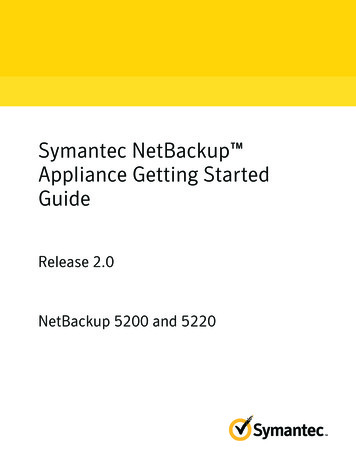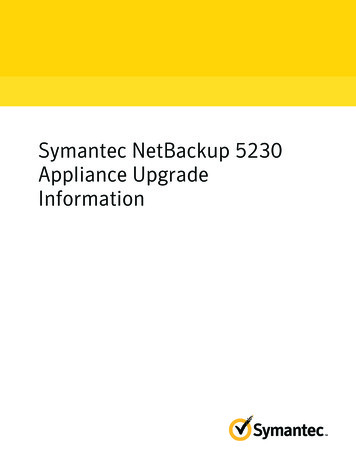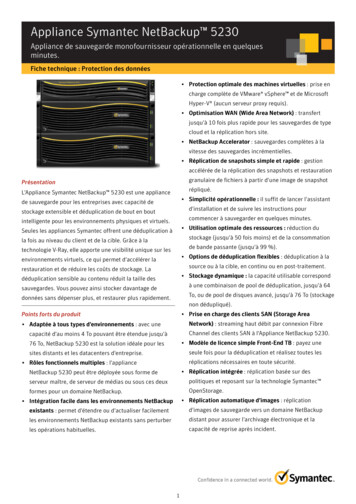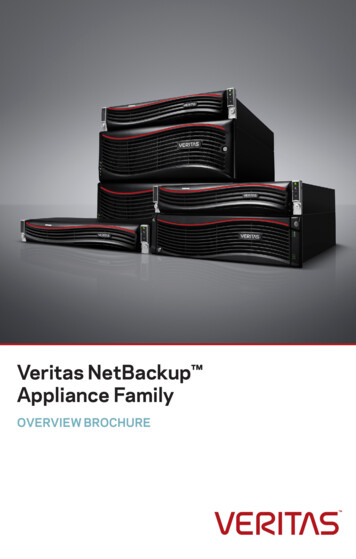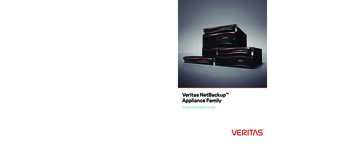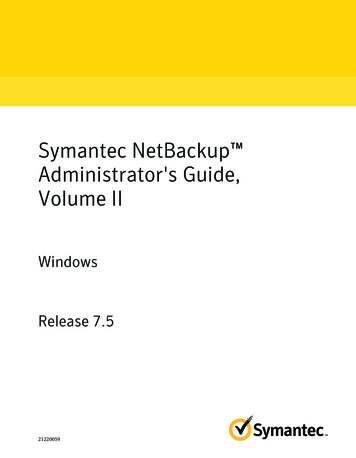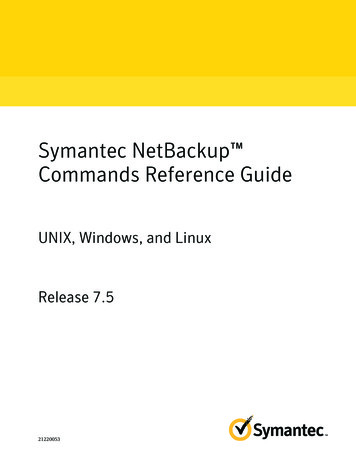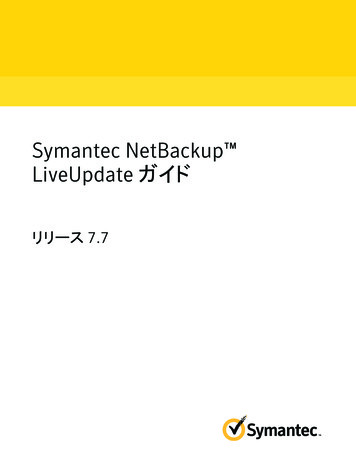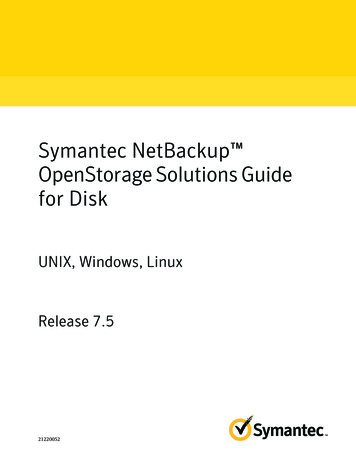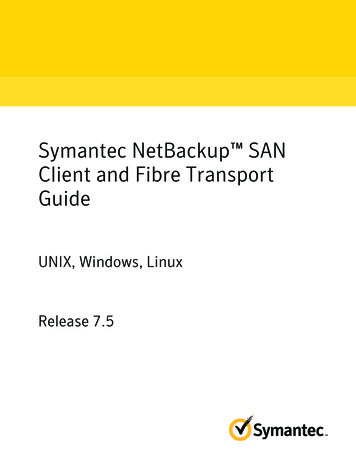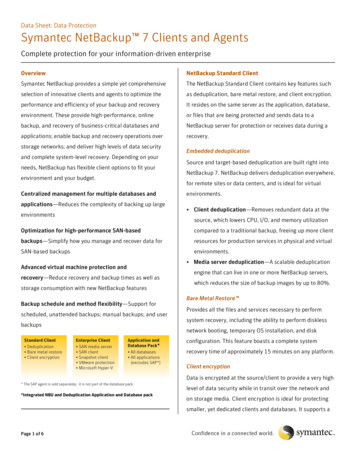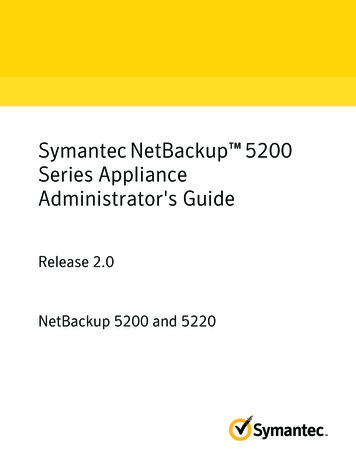
Transcription
Symantec NetBackup 5200Series ApplianceAdministrator's GuideRelease 2.0NetBackup 5200 and 5220
The software described in this book is furnished under a license agreement and may be usedonly in accordance with the terms of the agreement.Documentation version: 2.0PN:Legal NoticeCopyright 2010 Symantec Corporation. All rights reserved.Symantec and the Symantec Logo are trademarks or registered trademarks of SymantecCorporation or its affiliates in the U.S. and other countries. Other names may be trademarksof their respective owners.This Symantec product may contain third party software for which Symantec is requiredto provide attribution to the third party (“Third Party Programs”). Some of the Third PartyPrograms are available under open source or free software licenses. The License Agreementaccompanying the Software does not alter any rights or obligations you may have underthose open source or free software licenses. Please see the Third Party Legal Notice Appendixto this Documentation or TPIP ReadMe File accompanying this Symantec product for moreinformation on the Third Party Programs.The product described in this document is distributed under licenses restricting its use,copying, distribution, and decompilation/reverse engineering. No part of this documentmay be reproduced in any form by any means without prior written authorization ofSymantec Corporation and its licensors, if any.THE DOCUMENTATION IS PROVIDED "AS IS" AND ALL EXPRESS OR IMPLIED CONDITIONS,REPRESENTATIONS AND WARRANTIES, INCLUDING ANY IMPLIED WARRANTY OFMERCHANTABILITY, FITNESS FOR A PARTICULAR PURPOSE OR NON-INFRINGEMENT,ARE DISCLAIMED, EXCEPT TO THE EXTENT THAT SUCH DISCLAIMERS ARE HELD TOBE LEGALLY INVALID. SYMANTEC CORPORATION SHALL NOT BE LIABLE FOR INCIDENTALOR CONSEQUENTIAL DAMAGES IN CONNECTION WITH THE FURNISHING,PERFORMANCE, OR USE OF THIS DOCUMENTATION. THE INFORMATION CONTAINEDIN THIS DOCUMENTATION IS SUBJECT TO CHANGE WITHOUT NOTICE.The Licensed Software and Documentation are deemed to be commercial computer softwareas defined in FAR 12.212 and subject to restricted rights as defined in FAR Section 52.227-19"Commercial Computer Software - Restricted Rights" and DFARS 227.7202, "Rights inCommercial Computer Software or Commercial Computer Software Documentation", asapplicable, and any successor regulations. Any use, modification, reproduction release,performance, display or disclosure of the Licensed Software and Documentation by the U.S.Government shall be solely in accordance with the terms of this Agreement.
Symantec Corporation350 Ellis StreetMountain View, CA 94043http://www.symantec.comPrinted in the United States of America.10 9 8 7 6 5 4 3 2 1
Technical SupportSymantec Technical Support maintains support centers globally. TechnicalSupport’s primary role is to respond to specific queries about product featuresand functionality. The Technical Support group also creates content for our onlineKnowledge Base. The Technical Support group works collaboratively with theother functional areas within Symantec to answer your questions in a timelyfashion. For example, the Technical Support group works with Product Engineeringand Symantec Security Response to provide alerting services and virus definitionupdates.Symantec’s support offerings include the following: A range of support options that give you the flexibility to select the rightamount of service for any size organization Telephone and/or Web-based support that provides rapid response andup-to-the-minute information Upgrade assurance that delivers software upgrades Global support purchased on a regional business hours or 24 hours a day, 7days a week basis Premium service offerings that include Account Management ServicesFor information about Symantec’s support offerings, you can visit our Web siteat the following URL:www.symantec.com/business/support/All support services will be delivered in accordance with your support agreementand the then-current enterprise technical support policy.Contacting Technical SupportCustomers with a current support agreement may access Technical Supportinformation at the following URL:www.symantec.com/business/support/Before contacting Technical Support, make sure you have satisfied the systemrequirements that are listed in your product documentation. Also, you should beat the computer on which the problem occurred, in case it is necessary to replicatethe problem.When you contact Technical Support, please have the following informationavailable: Product release level
Hardware information Available memory, disk space, and NIC information Operating system Version and patch level Network topology Router, gateway, and IP address information Problem description: Error messages and log files Troubleshooting that was performed before contacting Symantec Recent software configuration changes and network changesLicensing and registrationIf your Symantec product requires registration or a license key, access our technicalsupport Web page at the following URL:www.symantec.com/business/support/Customer serviceCustomer service information is available at the following URL:www.symantec.com/business/support/Customer Service is available to assist with non-technical questions, such as thefollowing types of issues: Questions regarding product licensing or serialization Product registration updates, such as address or name changes General product information (features, language availability, local dealers) Latest information about product updates and upgrades Information about upgrade assurance and support contracts Information about the Symantec Buying Programs Advice about Symantec's technical support options Nontechnical presales questions Issues that are related to CD-ROMs or manuals
Support agreement resourcesIf you want to contact Symantec regarding an existing support agreement, pleasecontact the support agreement administration team for your region as follows:Asia-Pacific and Japancustomercare apac@symantec.comEurope, Middle-East, and Africasemea@symantec.comNorth America and Latin Americasupportsolutions@symantec.com
ContentsTechnical Support . 4Chapter 1Overview . 11About the NetBackup Appliance .About the NetBackup appliance components .About appliance console components .About using the links on the title bar .About the Topology pane .About using Web browser bookmarks .About the Master Server role .About Media Server roles .Installing NetBackup client software on clients used withappliances .About the NetBackup appliance graphical user interface .About the NetBackup Appliance documentation .Chapter 21114151616171718181920Understanding the NetBackup appliancesettings . 23About modifying the appliance settings .About NIC port bonding .Changing Network Configuration settings .Changing DNS Configuration settings .Changing the Administrator's password .Changing the Date and Time Configuration .Resizing appliance disk storage units .Changing the Fibre Transport settings .About hardware monitoring and alerts .About the appliance UI hardware monitoring and alerts .About Email notification from the NetBackup 5200 .About the Call Home feature .About Configuring SMTP .Settings Configuration SMTP server options .Configuring SMTP server settings for appliance .About using SNMP .About SNMP .2425262829303134343538404242434444
8ContentsAbout SNMP versions .About the Management Information Base (MIB) .Settings Configuration SNMP Server options .About Nirvanix cloud storage .Chapter 3Managing a NetBackup appliance . 47About the Manage views .About software release updates .About the Manage Appliance tab .Installing software release updates from the appliance UI .Installing software updates using the appliance shell menu .About rolling back to a previous software update .About installing and rolling back an EEB .Installing an EEB .Rolling back an EEB .About appliance supported tape devices .Adding external robots to the NetBackup appliance .About disk storage configuration .About license key management on the NetBackup appliance .Managing license keys on the NetBackup appliance .Expanding the bandwidth on the NetBackup appliance .About the NetBackup Appliance communications connections .Chapter 447484952535557575959606162626364Disaster recovery . 67About disaster recovery .About reimaging a NetBackup appliance .Reimaging a NetBackup appliance from the USB flash drive .Reimaging a standalone appliance .Reimaging an appliance with a storage expansion unitconfigured .Chapter 5444545466768697070Decommissioning an appliance . 71About decommissioning an appliance . 71Decommissioning a NetBackup master appliance . 72Decommissioning a NetBackup media appliance . 72Chapter 6Troubleshooting. 75About troubleshooting the appliance . 75NetBackup Appliance log file location information . 75About password recovery . 77
ContentsAppendix AAbout Call Home upload information . 79About the appliance hardware information that is uploaded . 79About the enclosure information that is uploaded . 82Appendix BTechnical specifications. 87Technical specifications for NetBackup appliances .Safety and EMC standards compliance for NetBackupappliances .Industry standards compliance for NetBackup appliances .Certifications for NetBackup appliances .FCC information for NetBackup appliance users .Index8789909193. 979
10Contents
Chapter1OverviewThis chapter includes the following topics: About the NetBackup Appliance About the NetBackup appliance components About appliance console components About using Web browser bookmarks About the Master Server role About Media Server roles Installing NetBackup client software on clients used with appliances About the NetBackup appliance graphical user interface About the NetBackup Appliance documentationAbout the NetBackup ApplianceThe NetBackup Appliance version 2.0 is a NetBackup solution that simplifies theinitial configuration and daily management of your backup environment. Thegoal is to provide a solution that eliminates the need to provide dedicatedindividuals to manage their backup environment.In this release, you can determine what role you want to configure the applianceto perform. You can choose to configure your appliance as a master serverappliance. You can choose to configure your appliance as a media server for usewith an existing master server appliance. Or you can configure your appliance asa media server for use in an existing NetBackup environment. With each of theseconfigurations, you get the added benefit of internal disk storage.
12OverviewAbout the NetBackup ApplianceThis appliance allows for easy expansion of existing NetBackup environmentsthat have NetBackup 7.1 or greater installed. The appliance also includes its ownbrowser-based interface that is based on the NetBackup OpsCenter managementconsole. This interface is used for local administration of the network, internaldisk storage, and tape libraries. If you configure the appliance as a master serverappliance, you can use the interface to manage backup policies, storage lifecyclepolicies, and storage units.Note: Currently, NetBackup appliances are supported for use only in Englishlocales. If you attempt to use non-English Windows or UNIX clients with NetBackupappliances, backup and restore results may be unpredictable.The NetBackup appliance supports the following features: 8, 16, or 32 TB of deduplication capacity per appliance. This built-in client andmedia server deduplication can reduce the size of the backups by as much as50 times. It also reduces the bandwidth utilization of the backups by up to 99%versus traditional backup approaches. NetBackup SAN Client and Fibre Transport. SAN Client is a NetBackup optionalfeature that provides high speed backups and restores of NetBackup clients.Fibre Transport is the name of the NetBackup high-speed data transportmethod that is part of the SAN Client feature. The backup and restore trafficoccurs over a SAN, and NetBackup server and client administration trafficoccurs over the LAN. NetBackup preinstalled. Helps to simplify the deployment and can be easilyintegrated into an existing NetBackup environment. Tape out option. The appliance includes a gigabit, dual-port Fibre Channelhost bus adapter (HBA). Hardware component monitoring. The appliance can monitor key hardwarecomponents such as the CPU, disks, memory, power supply modules, and fans.In addition, the appliance provides an optional call home feature that allowsproactive monitoring and messaging of these NetBackup components. The appliances support all core NetBackup software agents. The NetBackupagents optimize the performance of critical databases and applications. Thefollowing agents are supported: IBM DB2 Informix Lotus Notes and Lotus Domino Server Microsoft Active Directory
OverviewAbout the NetBackup Appliance Microsoft Exchange Server Microsoft SharePoint Portal Server and Microsoft Office SharePoint Server Microsoft SQL Server Oracle SAP Sybase Symantec Enterprise VaultFlexible hardware configuration. The appliance can be ordered in a variety ofconfigurations to provide the necessary Ethernet ports. Two 1 GB Ethernetports are provided on the motherboard. Expansion cards can be specified toprovide additional 1GB or 10 GB Ethernet ports, in dual-port or quad-portconfigurations.See “About the NetBackup appliance components” on page 14.The following describes how you can incorporate this appliance into your currentNetBackup environment:Replace unsupported media Replace an existing media server that runs on a platformserversthat is not supported in NetBackup 7.1.Add deduplication capability Add the appliance to an existing NetBackup environmentor replace an existing media server that does not supportdeduplication. Add NetBackup AdvancedDisk support for fasterbackups.Add more storage capability Add storage capability to an existing NetBackup 7.1environment.The internal disks can be used for additional backup storage.By default, the appliance is configured for deduplicationstorage. You can change the configuration to AdvancedDiskstorage, or partition the drives for both deduplication andAdvancedDisk storage types.Tape backupThe appliance includes a Fibre Channel host bus adaptercard for a TLD tape storage device for archive support.This appliance contains everything you need to start using NetBackup 7.1. Afteryou mount the appliance in a rack in your lab, you are ready to connect it andconfigure it to your network. After you have successfully configured yourappliance, you can install and configure your media servers and clients. Once that13
14OverviewAbout the NetBackup appliance componentsis done you are ready to run a backup of your environment. You can back up andmonitor up to 50 clients.About the NetBackup appliance componentsYou can order a NetBackup appliance that is either a 19-inch, 4U rack-mountserver or a 19-inch, 2U rack-mount server.The following describes the primary components that make up your 4U rack-mountappliance:Server hardwareconfiguration19-inch, 4U rack-mount server with dual Intel E5620processors 32 GB RAM LSI 8708 EM2 RAID controller Twenty-four 2-TB disk drives Two disk drives for OS partition Two disk drives for global hot spares20 disk drives for a RAID 6 data partition (32 TBformatted storage) 4-Gbps Dual-port QLogic QLE 2462 FC card Factory installed software Two 1 Gbps Ethernet ports (motherboard) Two 10 Gbps Ethernet ports (PCIe NIC) NetBackup appliance-specific software NetBackup 7.1 (Enterprise Server)NetBackup Deduplication and AdvancedDisk storageoptions (associated license keys are required but are notincluded) Administrative Web user interface (UI) Other Linux operating system (provided by Symantec) NetBackup LiveUpdate NetBackup 5200 Series Administrator's Guide Mounting hardware AC power cords Network cables Symantec NetBackup 5200 Series Getting Started Guide NetBackup 5200 Series 16GB USB Flash drive recoverymediaSee the included packing list for a complete list of thepackage contents.
OverviewAbout appliance console componentsThe following describes the primary components that make up your 2U rack-mountappliance:Server hardwareconfiguration19-inch, 2U rack-mount server with dual Intel E5620processors 24 GB RAM Intel SROMBSASMP2 RAID controller Ten 1-TB disk drives Two internal disk drives under Intel Embedded serverRAID Technology II (RAID 1) for OS partition One disk drives for hot spareSeven disk drives for a RAID 6 data partition (4 TBformatted storage) Four 1 Gbps Ethernet ports (PCIe NIC) Two 1 Gbps Ethernet ports (motherboard) Optional: Two 10 Gbps Ethernet ports (PCIe
method that is part of the SAN Client feature. The backup and restore traffic occurs over a SAN, and NetBackup server and client administration traffic occurs over the LAN. NetBackup preinstalled. Helps to simplify the deployment and can be easily integrated into an existing NetBackup e
